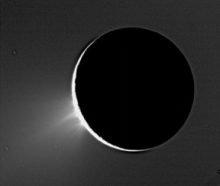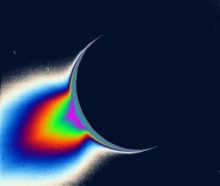A Moon’s Icy Spray
Jets of icy particles stream from one of Saturn's moons.
By Emily Sohn
At Yellowstone National Park in Wyoming, geysers such as the famous Old Faithful regularly spout water hundreds of feet into the air. The jets are impressive, but they’re nothing compared to geysers on one of Saturn’s moons.
 |
|
Images from the Cassini spacecraft, which is orbiting Saturn, show a fine spray of material (lower left) emerging from Saturn’s moon Enceladus. |
| NASA/JPL/Space Science Institute |
The tiny moon, called Enceladus, measures just 300 kilometers (186 miles) across. Recent pictures of areas near the moon’s south pole show that icy geysers shoot up another 300 kilometers, as high as the moon is wide.
The images came from the Cassini spacecraft, which has been on tour around Saturn and its many moons since July 2004.
Last July, instruments on Cassini detected a large cloud of water vapor floating above the southern polar region of Enceladus. At the time, astronomers suspected that breaks in the moon’s surface allowed ice to vaporize and fuel the cloud.
 |
|
In this colorized image, the colors reveal how far out from Enceladus the moon’s fountains of icy particles extend. The plumes appear to be as large as the moon itself. |
| NASA/JPL/Space Science Institute |
The new images give a more specific idea of how that might happen. They also prove that the moon is geologically active.
Scientists are giddy with the discovery. “There is little that can compare to the sighting of activity on another solar system body,” says Carolyn Porco. “This has been a heart-stopper.” Porco is the Cassini imaging team leader at the Space Science Institute in Boulder, Colo.—E. Sohn
Going Deeper:
Cowen, Ron. 2006. Moon spray. Science News 169(Jan. 7):13. Available at http://www.sciencenews.org/articles/20060107/note11.asp .
Additional information about activity on Saturn’s moon Enceladus can be found at saturn.jpl.nasa.gov/science/moons/moonDetails.cfm?pageID=5 and saturn.jpl.nasa.gov/news/press-release-details.cfm?newsID=620 (JPL/NASA).
Sohn, Emily. 2004. Ringing Saturn. Science News for Kids (July 28). Available at http://www.sciencenewsforkids.org/articles/20040728/Feature1.asp .







